We’ve taken a look at JVC’s entry-level DLA-X35 and the step-up X55 projectors, and now it’s time for us to examine the company’s second-from-top DLA-X75 D-ILA projector.
Priced at around £6,500, the JVC DLA-X75 (also sold in the UK as the DLA-X75R or DLA-X75RBE) is naturally moving further out of the entry-level market, and more into “serious film lover” territory. As with the DLA-X55, the X75 features JVC’s “4k E-Shift 2” technology, which exploits the high refresh rate of the D-ILA panels to give the appearance of a higher resolution image with less visible pixel gaps (should the user choose to enable it, that is).
On top of the X55 feature set, the JVC X75 adds THX and ISF certification. As a result, the projector includes a THX picture mode, which will – in theory – produce a near-calibrated level of image quality out of the box. That’s a welcome addition, since the X55’s potential high level of colour accuracy was only achievable via calibration, with its best preset mode still being a little off. Less excitingly, there’s also an automatic lens cover (we felt the exclusion of this on the X55 was a little miserly).
Best of all, however, is the DLA-X75RBE’s higher specified contrast ratio, which is apparently achieved by JVC’s inclusion of higher-grade optical components in its higher-end models. Deep black levels are the claim to fame of the Japanese brand’s D-ILA technology, so any improvements on the already excellent performance of the lower-down version should be special indeed.
Time to cut the lights, barricade the windows, and put the JVC DLA-X75R through its paces!
| Display Technology | D-ILA (LCOS) |
| Approx. Lamp Life | 4000 hours (5000 in eco mode) |
| Lamp Product Code and Approx. Price | PK-L2312 / ~£230 |
| Lens Shift | Yes, H+V |
Unsurprisingly, the DLA-X75 strongly resembles the other units in JVC’s current projector lineup. However, it looks considerably more sleek than the cheaper DLA-X55, since it uses a vibrant glossy black plastic shell instead of a duller, “greyer” matte finish. The lens controls, which are for zoom, focus, as well as horizontal and vertical shift, are all motorised and controllable via the remote. Accordingly, the JVC DLA-X75RBE features several Lens Memory modes which allow it to accommodate multiple aspect ratios in one setup – provided your throw distance and screen aspect ratio allow this, of course.
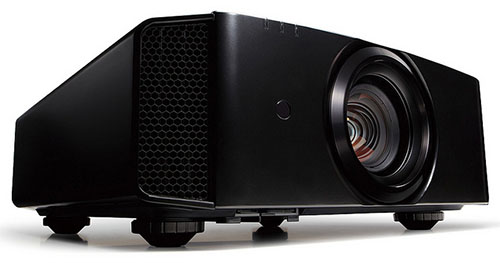
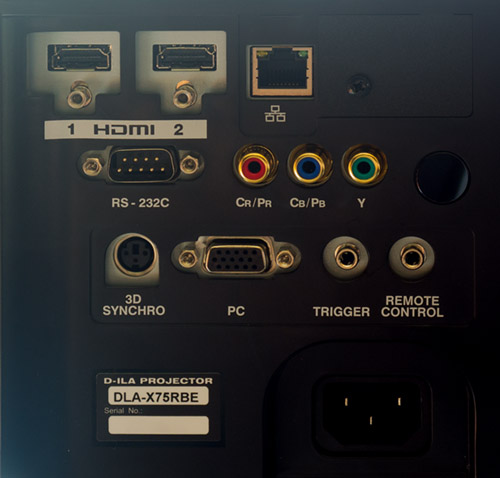 |
| Rear connections on JVC X75 |
![[Picture] menu](https://www.hdtvtest.co.uk/news/wp-content/uploads/2018/04/hardware_JVC-DLA-X55_menu1.jpg) |
| [Picture] menu |
JVC’s user menus are simple enough to use, but from our point of view as video calibrators, they do contain a sizeable amount of superfluous picture presets. As an example, there are no less than six top-level picture modes in addition to the (useful) five User memories. Selecting “Film”, as many users logically would, then reveals choices for [Color Profile] (there are three), and more sub-options within this.
The panacea to all this is the THX mode. This simply delivers (reasonably) accurate video without confusing the user too much. Users who first get their new JVC DLA-X75R and haven’t yet had it calibrated would do well to use this mode until a technician pays a visit to do full calibration later.
Too many menu options is better than too few, of course, and if JVC feels this helps their product stand out to consumers who aren’t aware of why it’s genuinely special, then so be it.
![[MPC] menu](https://www.hdtvtest.co.uk/news/wp-content/uploads/2018/04/hardware_JVC-DLA-X55_mpc.jpg) |
| [MPC Level] menus |
As for the “User” modes, let’s describe these to give calibrators an idea of what they’ll be working with. After opting for one of these modes, the first selection possible is the [Color Profile], which has an enormous number of options, some of which relate to different genres of film (there are modes for “Anime”, for example, although thankfully all professional HD content is mastered for use with a single colour gamut, so switching modes for different films isn’t necessary, or a good idea).
Moving down, there are selections and adjustments for [Color Temp.] (greyscale preset), [Gamma], and then [Dark/Bright level] and [Picture Tone], the latter two being more consumer-friendly naming for the aforementioned.
As well as the basic video controls, the [Advanced] submenu houses adjustments for JVC’s edge-adaptive 1080p->2160p (“4K”) upscaling process, in a menu called [MPC Level]. You can leave this option off entirely if you’re not a fan of the “4K E-Shift 2” mode (which we explained in some detail in our review of the JVC DLA-X55). The quick version is that the DLA-X75 is not a 2160p/4K projector, but instead achieves some of the benefits of a higher resolution (namely a less visible pixel grid structure) with temporal pixel shifting tricks. The LCOS imagers in the projector are 1920×1080.
There’s a submenu for Noise Reduction controls, which users should be careful with: the [RNR] (Random Noise Reduction) control comes set in one of its “on” positions, and should be shut off to avoid blurring out film grain textures and other fine details. The motion resolution of LCD and LCOS projectors (especially those without dark frame insertion, like JVC’s) already causes fine motion details like these to appear a little indistinct, so this is definitely video processing that celluloid lovers can pass by.
The remainder of the picture menu is made up of the manufacturer’s [Custom Gamma] editor (which is excellent), the [Color Management] submenu, an option to rename the “User” modes, and control over the [Lens Aperture] (to allow less or more light to escape from the projector) and the [Lamp Power] (the “Low” setting results in much quieter operation and longer life). Lastly, there’s the [Clear Motion Drive], which largely controls motion interpolation features, for which we don’t have any use (they improve the motion clarity but also introduce the “soap opera effect”). An “Inverse Telecine” control is included in this menu too, but here in Europe it will be of limited use given that most of our usage of the projector will be with genuine 24p content from Blu-ray, and sped-up 25fps content on television.
Note: Our JVC DLA-X75RBE review sample was calibrated using Calman Professional, the industry-leading video calibration software. These measurements reflect the projector shooting into the lens of our colorimeter.
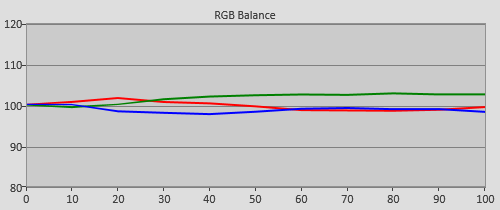 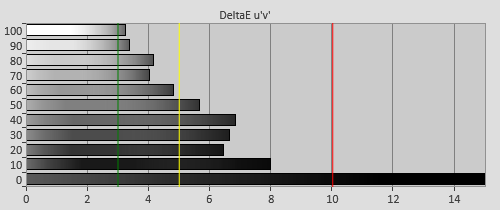 |
| Pre-calibration RGB tracking and delta errors (dEs) |
Given that the purpose of the THX mode is to provide “as accurate as possible” picture quality out of the box, we naturally used this as the basis for our pre-calibration measurements. It actually performs very well indeed, in fact, surprisingly so, given the unit-to-unit variation involved with UHP (Ultra High Performance) lamps. Greyscale mixing was slightly too green, with an excess of red in shadowed areas combining to give a slight beige cast to the picture.
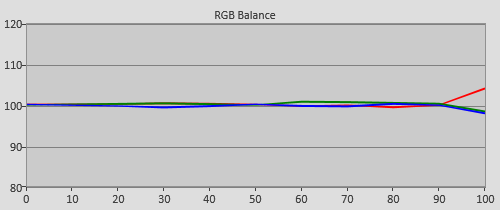 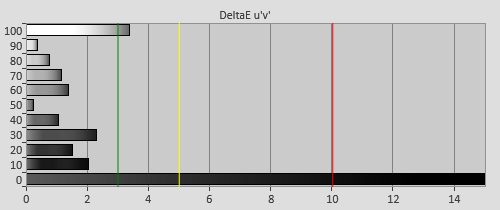 |
| Post-calibration RGB tracking and dEs in [User1] mode |
Achieving flat greyscale tracking on JVC projectors isn’t usually difficult (at least not when the lamp is new – as with any UHP-based projector, things can become less predictable as time takes its toll). Our DLA-X75R review sample displayed linear greyscale tracking even before calibration (meaning that the overall tint may have been a little off, but it was a little off in a fairly consistent way across the dynamic range). Therefore, we weren’t surprised when we achieved a mostly accurate result with only the basic two-point [Color Temp] adjustment. We did make use of the separate red, green and blue adjustments in JVC’s multi-point gamma control menu to further reduce errors, resulting in a projector with no greyscale issues. (We could have reduced the red tint at 100% white by lowering the Contrast, but given that it was a largely statistical problem, and we were shooting onto a large screen and needed every lumen of light possible, we chose to simply leave it alone).
![Pre-calibrated Gamma tracking in [User1] mode](https://www.hdtvtest.co.uk/news/wp-content/uploads/2018/04/hardware_JVC-DLA-X75_pre-gamma.png) | ![Post-calibrated Gamma tracking in [User1] mode](https://www.hdtvtest.co.uk/news/wp-content/uploads/2018/04/hardware_JVC-DLA-X75_post-gamma.png) |
| Pre-calibration gamma tracking (avg. 2.08) | Post-calibration gamma tracking (2.4) |
Adjusting gamma (the proportion of light output by the projector relative to the incoming video signal) was the single most worthwhile part of calibration on the JVC DLA-X75. In the pre-calibrated THX mode, we measured an average gamma of 2.08, which produces a much less “rich” picture than the dark-room mastering standard of 2.4. We’re unsure what the reason for this is, since THX should, as far as we’re aware, target a flat 2.2.
In any case, adjusting the projector to produce 2.4 wasn’t difficult, thanks to JVC’s custom [Gamma] adjustment menu. Like most manufacturers – but unlike Sony – JVC has wisely included this screen in the projector itself, rather than requiring the user to interface the unit with a PC in order to edit gamma.
Taking into account the differences in colour reproduction created by the pre- and post- calibrated gamma, the JVC did a great job at all times. The [THX] mode featured linear, accurate chromaticity at each measured point, and without any noticeable luminance errors. In other words, even before calibration, there were no stand-out colour inaccuracies that weren’t a knock-on effect of an inaccuracy elsewhere.
![Pre-calibration CIE chart in [THX] mode](https://www.hdtvtest.co.uk/news/wp-content/uploads/2018/04/hardware_JVC-DLA-X75_pre-strack.jpg) |
| Pre-calibration CIE chart with reference to HD Rec.709 |
![Pre-calibration colour errors in [THX] mode](https://www.hdtvtest.co.uk/news/wp-content/uploads/2018/04/hardware_JVC-DLA-X75_pre-strack-de.png) |
| Pre-calibration colour errors (<3 not appreciable to the eye) |
As is often the case, we found that using the CMS controls gently was the best strategy for overall colour accuracy. You’ll see that we’ve chosen to leave the red primary slightly oversaturated, because reducing this had a negative effect on the accuracy of red at 75% and below saturation, and affecting this point would result in a bigger on-screen problem. On the whole, we were very happy with the colour accuracy produced by our JVC X75 review sample.
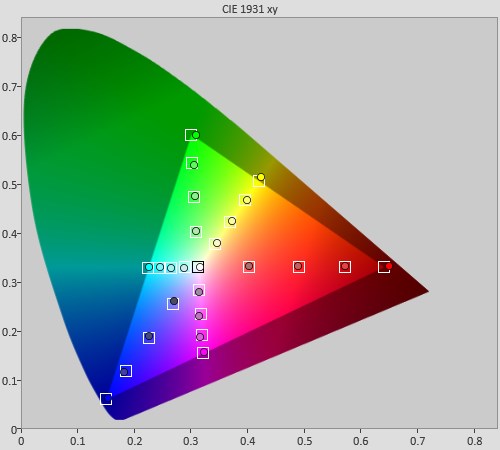 |
| Post-calibration colour saturation tracking |
![Post-calibration colour errors in [User1] mode](https://www.hdtvtest.co.uk/news/wp-content/uploads/2018/04/hardware_JVC-DLA-X75_post-strack-de.png) |
| Post-calibration colour errors (<3 not appreciable to the eye) |
| Dead pixels | None |
| Panel uniformity | Very Good |
| Primary chromaticity | Good (pre-calibration), Excellent (post-calibration) |
| Motion resolution (approx.) | 300 lines, 600 with motion interpolation enabled (not recommended for films) |
| Digital noise reduction | Defeatable |
| Sharpness | Defeatable |
| Luma/Chroma bandwidth (2D Blu-ray) | Full Luma, Full Chroma |
| 1080p/24 capability | No judder in 2D, subtle judder in 3D |
| Input lag | 70ms compared to lag-free CRT |
| Full 4:4:4 reproduction (PC) | Yes, in all modes |
Contrast performance is probably the best reason to look into JVC D-ILA projectors. While competing designs (DLP) can beat them on outright sharpness, JVC’s deep blacks and bright whites – which are achieved without the use of an iris in the light path – go a long way in providing the sort of depth that film lovers crave. Contrast performance, after all, is the most important attribute when it comes to picture quality.
Sure enough, the DLA-X75 delights with deep blacks, bright whites, and absolutely none of the luminance shifting that even the best dynamic iris implementations will result in.
One noteworthy point relates less to contrast performance and more to the perceived contrast performance. As we found out when calibrating the DLA-X75R, we saw that in the THX picture mode, the projector produces a gamma of around 2.08. Although the THX mode still produced good picture quality (thanks largely to its accurate greyscale and colour properties), this is some way off the Hollywood dark-room mastering standard of 2.4. We definitely recommend having your projector calibrated to this standard if you’re using it in a properly light-controlled environment, where a gamma of 2.08 will produce a perceptibly greyer picture. It was after calibration that the exceptional contrast performance of D-ILA could be fully realised, no longer being held back by a low gamma.
From one extreme to another: motion resolution is one of the weaker attributes of any LCD or LCD-derived projector, JVC’s included. While the motion clarity is sufficient to watch 24fps films without too much in the way of visible blur, the fact is that on the 60-fields-per-second FPD Benchmark test chart, the DLA-X75RBE can only resolve the usual LCD figure of around 300 lines out of the possible 1080. That’s totally normal for LCD and LCD-like technology, but it’s still low compared to what you’d get out of a plasma television, if you’ll permit us to make an apples-to-oranges comparison.
The JVC X75 does feature two [Clear Motion Drive] settings, but both of these are frame interpolation modes which produce the “soap opera effect”. They do increase the motion resolution, however, but since it’s by way of motion interpolation, these features are not suitable for accurate playback of 24fps film source material. As a result, that means that the (justifiable) use of these modes is effectively limited to high-motion video content like televised sports – which, to be fair, is the type of content that needs the most help in this area. In other words, just as with most LCD TVs, we’d only recommend using the motion interpolation controls for television-like usage of the projector, and leave them off for film or film-like content.
Although they’re not for everyone, we’d like to register our interest for a Dark Frame Insertion mode on JVC projectors. If Sony’s LCOS implementation of this feature is anything to go by, this would substantially increase the motion resolution (Sony’s doubled it to 600 lines) and give a more authentic cinema-like look to the picture – although the added flicker these modes produce means that they’re not to everyone’s liking, in spite of their strengths. (We say “more authentic” to mean “more reminiscent of film projection”).
Optically, the JVC DLA-X75R gave the level of performance we’d expect from a 3-chip projector in this price range. Although the projected image doesn’t have the outright sharpness of DLP systems, the D-ILA rewards come in the form of incredibly deep blacks and high contrast performance, and of course, freedom from the “rainbow” motion artefacts that can be seen on those systems under certain circumstances.
Convergence on our review unit was good, with no coloured fringing caused by misalignment of the panels being visible from our seating position. As with any 3-chip system, some small false coloured edges can be visible if you’re unrealistically close to the screen, but we don’t think anyone will actually have a screen large enough to make this a problem in normal usage. JVC’s [Installation] menu allows you to shuffle the red, green and blue colour components by one-pixel increments (it’s called [Adjust(Pixel)], but we don’t imagine any DLA-X75s will have convergence issues severe enough to warrant that. You can also use the [Adjust(Fine)] menu, which allows you to actually re-scale the images being fed to the panels and therefore reduce any convergence issues with greater precision – although there will be a small resolution hit on that particular colour channel as a result. We chose not to use any of these controls, since convergence was already good and didn’t pose any real-world problems.
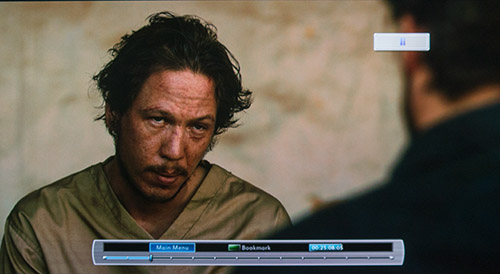
D-ILA’s pixel fill ratio is high enough to not produce much in the way of a “screen door effect” during normal viewing, but if you have a nearby comparison, it’s still possible for very observant viewers to spot a little gridding during bright scenes – that’s with the “E-Shift” system turned off, of course. Enabling this system (which effectively causes the output of the LCOS imagers to be shuffled back and forth diagonally at very high speed, as a means of presenting the appearance of higher resolution) makes the faint grid all but invisible.
We gave Universal’s recent Blu-ray Disc of Zero Dark Thirty a watch on the DLA-X75, and were very happy with the performance, as outlined. Pre-calibrated picture quality was already of a high standard thanks to the fairly accurate greyscale and colour properties, although we once again point to the improvements made to gamma tracking – specifically bringing it in line with the dark-room mastering standard of 2.4 – as the single biggest improvement made during our adjustments. Due to the way our eyes react in dark, light-treated environments – and that’s hopefully the sort that a projector of this quality will be going into – a higher gamma results in the perception of deeper black levels, even if the actual dark luminance doesn’t change. (Care does need to be taken during calibration to avoid discarding details just above black, though).
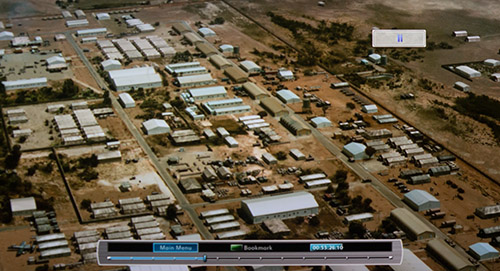
The JVC DLA-X75RBE also has no judder issues, with 24p input being processed by the entire display system in a way which doesn’t add any stuttering or 60hz-centric pulldown judder. All in all, other than reinstating a dark frame insertion mode, we don’t feel there’s much JVC could do to improve the experience that wouldn’t involve some sort of redesign.
The JVC X75 is yet another commendable home cinema projector, and once again, is a step-up compared to the lower-down X35 and X55 models, with improvements in out-of-the-box colour accuracy (thanks largely to the THX mode), contrast performance, and also some subtle factors relating to optical quality.
As usual with D-ILA technology, the star of the show is the exceptional contrast performance. Blacks are noticeably darker than most competitors, and although we thoroughly recommend that users install projectors into light-treated rooms (with reflective surfaces covered) for the highest contrast performance at all times, the DLA-X75’s deep blacks will still be visible in non-ideal environments during darker content.
We’ll say it again… we’d love to see Dark Frame Insertion on future JVC projectors, because this feature combined with their leading native contrast performance would be a killer combination. Many users just can’t tolerate the added flicker, and this is a more personal aesthetic preference for lovers of film (the material as well as the medium), however.
As it stands, JVC’s DLA-X75 left us with a thoroughly satisfying home cinema experience. We also look forward to checking out the top-end DLA-X95 that promises even higher contrast ratio, which we’re assured is possible.
